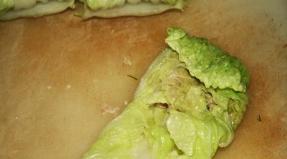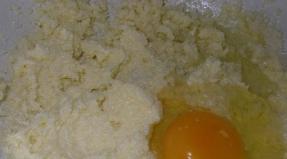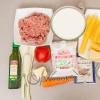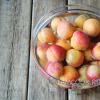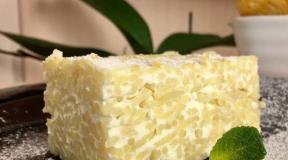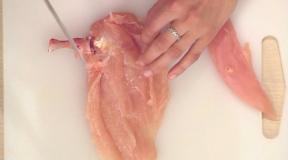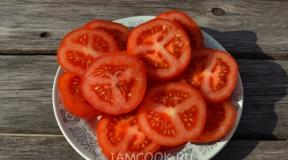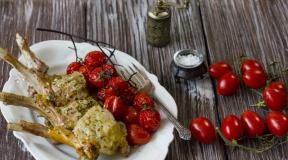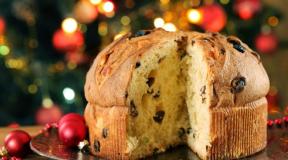School lunches around the world. What is eaten for lunch around the world
Have you ever wondered what is eaten for lunch around the world? We became interested and decided to find out what traditions there are in some countries. We share the result with you.
We have already written about how in 11 countries of the world. Today let's see how they used to dine in Brazil or, for example, in Denmark.
Brazil
Let's start with Brazil - in this country they dine heartily and hearty. Their breakfast is not particularly plentiful - coffee, buns and fruit, but lunch consists of several dishes.
As a first course, you can eat soup - takako or watapi. Brazilians love seafood, so it's no surprise that both soups have shrimp in them. Thick yellow takako soup generously flavored with garlic and seasoned with shrimp. Watapi soup is made from coconut milk, shrimp, peanuts and palm oil. It turns out very satisfying, but there is also a second one!
On the second they eat bacalhau, rice with beans, and on holidays and weekends they serve a dish called feijoada. Bacalhau is dried and salted cod that is soaked in water for a long time and then cooked as usual. The tradition of salting and drying cod came from Portugal, and still many foreigners do not understand why it is impossible to buy fresh cod instead of fiddling with dried cod for a long time.

Feijoada is a dish of meat, beans and cassava flour. The dish is usually served in a pot, it contains a lot of spices, and complements it with cabbage and oranges. Each region of Brazil has its own signature feijoada recipe.

America
Compared to the bright and spicy lunches of Brazil, American lunches look a little dull. As a snack, most Americans eat salad, then - sandwiches, burgers or tacos. If someone is very hungry, he can eat steak and french fries.

Italy
In Italy, lunch is given as much as three hours. This is the most important meal for sociable Italians: they gather in a large company, discuss their affairs, share their feelings and eat a lot, with feeling.
Lunch starts with appetizers antipasti: cheese slices, vegetables, assorted snacks. Italians are very fond of carpaccio- raw meat flavored with spices and sprinkled with cheese.

Then comes the turn of the first courses. First, you will be offered pasta, risotto, gnocchi or lasagna. However, you can always eat a soup that is more familiar to us - for example, minestrone.

The second is served baked or fried. meat, bird or fish. Italians use vegetables as a side dish, not potatoes. Of course, we must not forget about pizza.

Finally, the turn of desserts comes. You will be served fruit or cheese - the meal begins with it and ends with it.
Greece
Lunches in Greece are quite simple. Greeks eat a lot vegetable salads seasoned with a variety of sauces. Served as a main dish for lunch seafood, grilled meat, pasticio and moussaka. Be sure to have fresh bread and wine.
Pastizio is a pasta casserole with minced meat. The uniqueness of this dish is given by bright and fragrant sauces.

Moussaka is also known outside of Greece. A casserole of eggplant, minced meat and bechamel sauce is a great option for a hearty lunch.

Germany
Interestingly, in Germany they eat very little bread at dinner. Most often eaten meat, pasta, rice or noodles, fish with vegetables.

german sausages with garnish: cabbage, carrots or broccoli.

And, of course, dessert. For dessert you can eat cottage cheese or tasty pudding.

Japan
If you like light lunches - you are in Japan. Here, unlike in Italy, they are not accustomed to spending a lot of time for lunch. The Japanese eat light soups, lot rice and boiled vegetables, fish. Served as an appetizer salads, and you need to drink everything tea. Japanese food does not have a lot of spices: here they believe that it is best to preserve the natural taste of food.
For example, for lunch you can be served Miso soup, which we would call broth.

And for the second - fish or other seafood rice and bowl with vegetables.

France
Refined French also do not welcome heavy meals, although their lunch lasts two hours: from noon to 2 pm. At this time, everyone goes to cafes, restaurants or home. Dinner starts easy lettuce, which has a lot of greens and vegetables.

Then - soup. It can be very easy chicken soup, and fragrant onion soup with croutons.

There is no second course here, the French eat meat or fish snacks, vegetables and will always be on the table cheese.

As a dessert, you can taste cake, croissant or biscuit. By the way, we already have madeleine cookies, so you can bake them for lunch in a French style.

Israel
In sunny and hot Israel people have lunch spicy salads as an appetizer. After salads, you have a choice between shawarma, hummus and falafel. Shawarma in Israel is prepared in a completely different way than in our country, there it is a whole art, and you can choose any additives. It is called in Israel "Shuarma".
By the way, we also wrote about hummus, offered you two options - and with. If you haven't made it yet, we recommend you give it a try!

Served for lunch on holidays and weekends B-B-Q– many Israelis have grills, can you imagine the flavor on the streets?

Denmark
Our selection is completed by funny Denmark. Why funny? It's very simple: for lunch, the Danes eat sandwiches with coffee. These are unique sandwiches, each of which can replace a full meal. Thick, with meat or fish, with vegetables, with eggs - what is there just not there!
Danes spread sauce on rye bread, then put fish and scrambled eggs, then vegetables, then another layer of sauce and a second piece of bread. It is considered a light sandwich, as well as a simple one with ham and cheese.

And to have a normal lunch, the Danes will order a complex sandwich that will need to be eaten with a knife and fork. There will be meat, pate, pickled cucumbers, cabbage - everything that is enough for imagination.

We invite you to take a look at the school lunches that are offered to children around the world. The most diverse dishes and the most unexpected sets of products - from scarce to plentiful, from quite healthy and balanced to frankly unhealthy, from rice porridge to American cheeseburgers and chocolates.
(Total 21 photos)

The country: Sweden
Compound: a dish of potatoes, cabbage and beans, as well as a cracker and berry juice.

The country: Japan
Compound: udon noodles, chikuwa (fish sausage) stuffed cheese, frozen tangerine, milk

The country: China
Compound: fish, scrambled eggs with tomato sauce, rice, spinach, cauliflower and soup.

The country: India
Compound: rice, curry sauce, masala.

The country: United Kingdom
Compound: potatoes, peas, other ingredients are unfortunately not known.

The country: Tanzania
Compound: ugali (cornmeal porridge), chicken, herbs, sauce, watermelon salad.

The country: Czech Republic, Prague)
Compound: soup, rice with chicken goulash, dessert, juice and hot tea.

The country: South Korea
Compound: kimchi, pork, bean sauce (sammjang), cabbage, soup.

The country: Malawi
Compound: beans, cabbage and other vegetables.

The country: USA
Compound: cheeseburger, tater tots (melted cheese and potatoes), milk chocolate, chocolate puddings, and ketchup.

The country: Taiwan
Compound: left: pork with pineapple, radishes, carrots and green peppers, center: roasted vegetables with garlic, right: fish stew with cabbage ball, carrots, mushrooms and seaweed soup with egg.

The country: Philippines
Compound: kavali (traditional Filipino pork dish), liver sauce, rice.

The country: Sweden
Compound: chicken salad, knäckebröd(?) cottage cheese, carrots and sauce.

The country: Slovakia
Compound: smoked mackerel, bread, red pepper, tomato salad, kiwi, apples, milk and cake.

The country: Malaysia
Compound: noodles with shrimp, fish and eggs, a pack of juice, and an apple.

The country: Singapore
Compound: fried anchovies, scrambled eggs, roast cabbage and tomatoes, soy sprouts and chicken chop.
My interest in the school lunch menu of the world arose after meeting the blog of a 9-year-old schoolgirl from Scotland Martha Payne which has already become popular all over the world, especially among schoolchildren. Back in April 2012, Marta started a school food blog, NeverSeconds, where she regularly posts photos of her lunches and talks about how healthy they are. After some time, the school principal decided to ban the girl from taking pictures in the canteen, but there was no stopping her: children from all over the world began to send her photos of their school lunches, Martha received more than 10 million views, Scottish parents began to protest against harmful chocolate milk in the school diet , and British newspapers dubbed Martha "the new Jamie Oliver." Now the schoolgirl participates in the Mary's Meal charity program and saves starving children in Malawi, and a book about her and her blog has become a bestseller in England.
And it all started with the fact that Martha took a camera from her father and began to photograph her school lunches. Moreover, she introduced a 10-point rating scale, in the comments to the dishes she described what her portioned lunch consisted of, the taste of the ingredients, whether a hair was found, and even how many pieces would need to be taken from a fork or spoon to eat the entire dish.
1. Scotland.
The first photo was of a slice of pizza and a potato meatball, along with sweet corn and cookies for dessert.
Martha wrote: “The benefit of this blog is that now dad understands why I am hungry when I come home. She also complained about poor satiety: “I'm a growing child and I need to be concentrated during the day, but I can't do it on one meatball. Do any of you think he can?"
On the west coast of Scotland, where Martha lives, standards for school meals vary. Martha, with the permission of her teachers, took pictures of her £2 school lunches and gave them a grade. Says Marta: “When I started posting these photos, I thought only my family and friends would see them, so I was very surprised that so many people are worried about school meals. When I posted pictures of tea on my blog, the number of views exceeded 1 million!
The news of a student being banned from posting photos of her own meals sparked criticism from bloggers and Martha Payne's father. Petitions were even sent to the school demanding that the ban on photographing lunches in the school cafeteria be lifted. This extraordinary decision of the local authorities was also widely covered by local newspapers.
Hot dog, corn, croquette and dessert.
Local authorities did not take into account the strength and speed of reaction of social networks. Just a couple of days after the ban was introduced, Argyle and Bute County Superintendent Roddy McQuish acknowledged the mistake and ordered the ban lifted. “I changed my mind,” he admitted. “Censorship has no place in our district.”
Authorities have lifted a controversial ruling that banned a nine-year-old student from posting pictures of her school lunches on her blog. The Telegraph newspaper writes about this with reference to a high-ranking representative of the district administration.
Potato, pineapple, carrot sticks, pepper, ham and dessert.
By the way, Martha's mother works as a medical practitioner. The girl herself began to write because she was interested in journalism. The girl's father admitted to the press: “I'm shocked. Never thought to attract so much interest."
Since then, Marta has been quietly leading a blog so beloved by many.
Shepherd's pie with minced meat in gravy, fresh cabbage salad, cucumber, cake and melon.
Chicken noodle soup, rice, corn, vegetable spring rolls, milk chocolate shake.
One of Martha's favorite meals: Chicken curry, rice, broccoli, shortbread and ice cream.
Martha with actor Benedict Cumberbatch.
Now consider school lunches from other countries.
2. Finland.
Vegetarian soup with sausage, rye bread with cheese, cucumber and milk.
Braised sauerkraut with lingonberry jam; salad of cabbage, cucumber and grapes; milk.
Salad, curry chicken, served with beans and carrots, pudding, milk.
Here we need a little digression. In Finnish schools, there is no rigid menu - the children themselves choose from several dishes what they want to eat. The task of the teachers is to convince the children that 50 percent of the dinner should be salads and other healthy foods. Since school in Finland starts at the age of 5, the understanding of the “right” food is formed quite early.
Vegetable soup with potatoes, carrots, onions, broccoli and zucchini, rye bread, cheese and tomato.
Another small digression. In Finland the school day is usually short, sometimes up to 12 noon. Therefore, lunch is not so voluminous :)
Fried fish with pesto sauce; potato; salad with watermelon, cucumber and peach; milk.
3. USA.
Spokane, Washington. Cheese, lettuce, turkey, kiwi and cauliflower.
Chicago, Illinois. Spaghetti bolognese, fruits and vegetables.
Austin, Texas. Turkey salad, mashed potatoes, peach pie, iced tea.
Spaghetti, salad, lollipops, chocolate drink.
Atlanta, Georgia. Jewish school. The cost is $5.5. Beef tacos, rice, crispy noodles, hummus, seeds, chicken noodle soup.
San Diego. Chili with bread, salad bar, pineapples and milk.
4. United Kingdom.
Canteens have a vegetarian option on the menu (there are many Hindus in schools in the United Kingdom). Usually this peas, baked potatoes, quiche. Option: instead of potatoes, you can have cauliflower with cheese.
For ordinary students, as a rule, - sausage, hamburger or chicken nuggets, salad, apples.
Village of the West Midlands, England. Whole grain bread with lettuce and ham; apple and grapes; a cup of vegetables (tomatoes, radishes, sweet peppers);
5. Japan.
Sendai. Fish, seaweed, rice with tofu and egg, soup, salad with sesame dressing.
Yokohama. Pickled daikon radish, sour plums, konjac jelly (um... such a chewy extract from plants, as I understand it), green carrots, beans, garlic, white fish, vegetables and eggs boiled in soy glaze. In general, one burda :)))
Fried fish, dried seaweed, tomatoes, miso soup with potatoes, rice, milk.
Kagoshima. Rice, chicken soup, fried flying fish, steamed vegetables, milk. The cost is $2.9.
Fukushima.
Nagano.
6. China.
Nanning, Guangxi. Soup, pork with rice. The cost is 8 yuan or 0.80 euros.
Shanghai, German school. Sausage with French fries, carrot salad, a piece of cake.
7. Taiwan.
8. Germany.
Frankfurt am Main. Rye-wheat bread with butter, clementine, pomegranate seeds, homemade Turkish meatballs, candies. Cost: about 1.50€ (£1.20).
Rye-wheat bread with butter and gouda bunny cheese, cherry tomatoes and grape-cheese-sticks. Cost: about 1.30€ (£1.04).
Hamm, a city in western Germany. There is no canteen, only a cafe.
9. Israel.
Falafel, pita pieces, yoghurt with cucumber sauce, herbs.
10. Czech Republic.
Vegetable soup with semolina, beef with garlic, served with spinach and potato dumplings, orange.
Vegetable soup with dumplings; fish stew with mashed potatoes, peas and tomatoes.
Vegetable soup, Mexican rice with beans and corn, canned pineapples and peaches, lemon water.
Beef soup with noodles and carrots; fried steak with mashed potatoes; beets, celery salad, hot fruit drink.
11. Brazil.
Meat with rice, green salad, pudding, strawberry juice.
Fish, potatoes, tomatoes and bell peppers, rice, beans, zucchini. The cost is around R$10.00 (£3.16, $5).
12. South Korea.
Seoul. Rice, Kimchi soup, pork, fried dried seaweed, tofu with soy sauce, sweet rice cake. The cost is 2500 won or $2.5.
White rice, lettuce, shrimp, fried ketchup patties, kimchi and soup with pork bones and potatoes. The cost is the same, $2.5.
Fried rice with dried seaweed; soy paste stewed with green pumpkin, mushrooms and potatoes; kimchi radish, corn, cottage cheese casserole and grapes.
13.Spain.
Barcelona. Fried fish with tomatoes and lettuce, bread, apple.
Barcelona.
Cream of zucchini soup with fried bread; sea scallop with lettuce.
Catalan soup, grilled chicken breast with french fries.
Paella (rice with carrots, zucchini and pork loin), meatballs with potatoes.
14.Singapore.
Meat, rice, lettuce, melon.
15. India.
Chennai. Lentil soup, pumpkin salad (local variety), rice, cottage cheese, and semolina dessert (kesari), kefir.
Bangalore, Canadian International School. Fish nuggets, spring rolls, lettuce, noodles, melons, figs.
16. France.
Chicken nuggets with French fries and broccoli, bread, pasta with vegetables, salad and a slice of cake.
17. Sweden.
Vegetarian option: potatoes, coleslaw and beans, crackers and lingonberry juice.
18.Cuba.
Beans, rice, fried banana, a piece of fish.
19. Australia.
Pancakes with smoked salmon and cream cheese; grape tomatoes, strawberries. The cost is $5.
Melbourne. Chicken nuggets, banana and chips.
20. UAE.
Croissant stuffed with Middle Eastern spice mixture Za "atar, cucumber, carrot, strawberry, orange, fruit juice.
21.Ukraine.
Soup, a few pieces of sausage, pasta, pickles, bread, tea.
22. Estonia.
Tallinn. Red cabbage and beetroot salad, boiled rice, baked zucchini with cheese and tomato, cocoa. The cost is 2.3 euros.
HOW ARE US?
23.Russia.
In Moscow, a reform of the school food system has recently taken place. The kitchens where breakfasts and lunches were prepared were closed. Food is supplied by large factories that provide the so-called "flight meals". Dishes are delivered in the morning. In school canteens, they are only warmed up.
Moscow. The usual lunch in the capital's school: soup, cutlet with pasta, some vegetables and juice for baby food.

Kemerovo.
St. Petersburg. Some schools in the city have food from the Concord factory. The cost of lunch is 32 rubles.
Of course, there are no uniform dinners in countries. In private schools, the food is better, in public schools it is often worse. There are regions where meals are not provided at all - children bring food with them in lunch boxes. But in general, it is possible to imagine the peculiarities of lunches and the logic of doctors and cooks (in many countries, the school menu is coordinated with the sanitary services, in Russia, by the way, too).
lunch boxes .
But examples of lunches in lunch boxes that are prepared at home say a lot about the parents themselves and about their attitude to food and health, both their own and their child :))
England, Chester. Bean burger with chili sauce and cheese, shortbread.
USA. Chicken sandwich, salad, canned pineapple. The cost is $2.
USA. Dardanelles. Lake. Camp. Ramen noodles with green beans and almonds, Hawaiian mix, hot fruit juice, apple cider or hot chocolate of your choice. Cost: $2.32.
Georgia. Carrots, mixed fruits, peanut butter, bread and water.
Australia, Jakarta. Mini French toast with cream cheese and smoked salmon, fruit, carrots and yogurt.
Ireland. Croissant, apple, cucumber, croutons.
Ireland. Russian cuisine :)) Dumplings, cucumber, drinks.
Japan.
Canada. Fruits (blueberries, strawberries, raspberries), carrot sticks, peas, boiled egg and kefir.
France, Burgundy. Sandwich, carrot, apple, cheddar crackers and donut.
Sri Lanka. Rice in milk - Kiribath (traditional dish), fruits.
West Africa, Nigeria, Lagos. Jollof rice with chicken and beef. I'm surprised that in Africa they feed like that :). It's the same for lunch at school.
Of all the presented menus, I boldly choose the Czech Republic, Spain, Sweden, Finland and South Korea :))
And once again I am convinced that in the USA it is simply necessary to change the entire food system in schools, and in the bud. No wonder why there are so many fat people in the USA! All school years - continuous synthetics, chemistry and calories.
And how is it in your school, is the menu, prices satisfied?
In Moscow, the reform of school meals has been completed: if three years ago, food for children was cooked on site in every school, now it is centrally produced at 13 food processing plants and cooled, and then delivered to schools, where it is heated and served to children. (The same food plants also serve the city's kindergartens.)
The reform did not go smoothly, with many scandals: there were problems with supplies, then with the menu (after the introduction of the fortified menu two years ago, children developed allergies), then parents went out to protest, insisting that ready-made food with such a long shelf life could not be healthy and delicious.
Therefore, The Village decided to check what Moscow children are now being fed and find out why these same children so often refuse to eat in kindergarten or at school. We sent a request to the press service of the Concord company, the largest food supplier in Moscow, with a request to give us one sample of a school lunch. We never received an answer. (The school food vendors who feed your kids rarely talk to reporters at all.) Then we called more than 20 school principals in different parts of the city with the same request, and only one director allowed us to buy lunch in his cafeteria. The rest said that they did not want to spoil relations with suppliers: “Keep in mind that the topic of nutrition is one of the most criminogenic in education,” they warned us.
But the editors of The Village are not bad at it: we got three school lunches (95 rubles apiece) and asked Marianna Orlinkova, deputy editor-in-chief of the Gastronom magazine, author of the books About Snacks, About Soups, About Pasta, to taste the dishes and to tell your opinion.
Marianna Orlinkova
Deputy Editor-in-Chief of the magazine "Gastronom", author of the books "About appetizers", "About soups", "About pasta"
Lunch number 1
Sorrel soup with sour cream
and fish with mashed potatoes

Marianna Orlinkova:“First, a healthy good soup, although I don’t know which of the children will eat it. On the second - fish with mashed potatoes. I really don't like the word "stink", but that's the first thing that comes to mind. Strongly odorous fish, similar to hake, with a huge number of bones. This is not suitable for children, they will not pick out bones - even adults do not like to do this. Pink salmon would fit better here. Strange, sour taste potatoes. Maybe the puree was made with vegetable broth, but most likely just water with the addition of bay leaves or onions. If butter is there, it is heavily veiled. Any puree is eaten immediately after preparation, but in public catering this, of course, is impossible. It would be possible to brighten up the situation with the help of milk fats: butter or milk. Children do not like greens, but you can beat them in a blender with olive or vegetable oil, and then pour them into potatoes. For children to eat this fish, one could make wonderful meatballs out of it: cook minced fish, but put potatoes instead of bread. Any sauce is suitable for them - tomato, creamy or some other.
LUNCH #2
Beet salad and sausage with rice

M.O. : « Beetroot or, as I would call it, mayonnaise salad with beetroot: this should not be fed to children. Why does my child need two tablespoons of mayonnaise per serving? In the original, it was probably "Herring under a fur coat" . Now it's rubber cheese, beetroot, and just a tiny bit of walnuts. Beetroot is a wonderful product, but here the cooks apparently boiled it, although it would be more useful to bake it. As a result, they wanted to feed the child with something more or less useful, but it turned out the other way around. By removing the top layer, we would have a wonderful healthy meal. If you think kids won't eat beetroot without mayonnaise, sprinkle it with fresh soft feta-type cheese that kids love and you'll be fine. For the second course the cooks took a sausage of good quality, sprinkled it with grated cheese and herbs. Why is there greenery here? It is better to put it in rice, although, on the other hand, knowing the children, I will say that then they will not eat it. The beauty of the dish, of course, does not bother anyone, but the worst thing is that no one cares about the benefits. The corn in the garnish is canned, not fresh frozen, as it should be. Cheap rice, some spices. It can be eaten. Moreover, if they removed a huge amount of vegetable oil, which is four times more than it should be, then perhaps the dish would be even better. Apparently, they cooked rice with a dry mixture of vegetables and herbs. Technologically, this is easier than cutting endless tons of carrots. There can be no question of any benefit here: unhealthy sausage, bad cheese and frankly harmful mayonnaise, which can be replaced with sour cream, although this option is undoubtedly more expensive.
Lunch number 3
Macaroni with chicken and beetroot salad

M.O.: « Macaroni stuck together and overcooked to the state of porridge. Horns are the cheapest thing you can think of, there is no talk of any durum wheat here. Such boiled pasta is very fond of our grandmothers. Here it was necessary to take other pasta from durum wheat. The chicken is dried to the state of the sole. Fillet is obviously the most over-dried meat, the thigh would be lighter and tastier. It is not more expensive, but it is more fuss with it. On the second - again beetroot salad. The beets are cut into cubes and seasoned either with butter or with cheese. This time without mayonnaise, but it didn’t taste any better. But at least it's not that bad."
findings
Food should bring satisfaction, food and pleasure. The school food that we tried only gives satiety. If you show these school lunches to nutritionists, they will go crazy: the beets were killed with mayonnaise, the sausage is not meat, but a substrate of additives, preservatives, soy protein and starch. Instead of a sausage, a small piece of meat could be stewed for the child. There is, for example, a Moroccan way of long languishing of cheap meat (neck, drumsticks) - “tagine”. I don't think it will cost much more than a sausage. When a child is already taught at school to eat mayonnaise, which is eaten by 90% of Russian families, then why are we surprised that a Russian person eats everything with mayonnaise?
There is an understanding what healthy food is. Some believe that this is the food that contains all the substances a person needs (for example, meat with a side dish), others say that proteins and carbohydrates are poorly digested together and it would be good to eat meat, for example, with vegetables, and bread with vegetable soup . But at school, this is impossible: people are used to a certain type of food (pasta with sausage), and it will be necessary to rebuild the psychology of the entire population, which has remained unchanged since the famine.
now Russian chefs are being taught in culinary colleges to the same standards that were taught 25 years ago. These people can stick and fry a thousand cutlets in a day, but who needs it if the cutlets are tasteless? Moreover, today's children have different eating habits. For example, they like to eat in Japanese restaurants. Cooking rice rolls with a piece of fish or cucumber inside is inexpensive. Another story is sandwiches. Why don't we have them? It is not harmful if you make them with fish, meatballs, tomatoes, lettuce. But the problem is that the brains of the people who come up with the school menu are the same as they were 40 years ago. Regulations do not allow development in another direction.
In world practice there is a wonderful example of how Jamie Oliver changed the school food system in the UK. The state allocated a budget for which nothing could be cooked except hot dogs and pizza. Oliver approached this matter not only as a cook, but also as a technologist: he showed that it is possible to cook healthy food from vegetables and fruits. He suggested the same thing in America, but apparently they did not understand him there, since European and American children are still very different. In our country, this is impossible, because everyone knows that the school food system is corrupt. Trying to squeeze in there with ideas that we also had at Gastronom, you find yourself in a densely built system that lives by its own rules.
I have an example one friend of the Moscow school. Each school receives a certain amount of bread: black, white, whole grain with seeds. The last children do not eat. According to school rules, bread cannot be served the next day, as a new portion will be brought. You can’t feed the homeless with this bread either, because if you take it out of school, it will be considered theft. It would be possible to cook something out of it - for example, pudding, which the whole extension would eat with pleasure, but you can’t cook in the kitchen: everything is brought ready-made. It turns out that the only way out is to throw the bread in the trash. In total, including the remains of black and white, eight 450-gram loaves of bread are thrown away every day. If you multiply this by the number of Moscow schools, then in total you get the weight that can feed the whole of Zimbabwe. But the problem is that the schools themselves cannot control the situation with the supply of bread in any way, they have no right to say that they are not brought this or that kind: whether the children eat the food that was brought to them or not, no one cares.
DARIA SPITSYNA
second grade student
“In my school, I don’t like the first, although pickle, for example, is nothing, however, it is heavily salted. I like almost all main courses, especially mashed potatoes with fish cake. I would like for breakfast in the morning to be given, in addition to porridge and marshmallows, also a delicious bun.
DARIA POPUDNYAK
10th grade student
“At school, I usually have breakfast, but sometimes I also have lunch. For breakfast, most often porridge, tea or cocoa, it happens that they cook macaroni and cheese and sausages. I love vegetable salad, buckwheat porridge with stew and borscht. I hate hodgepodge and pea soup, but not because they are poorly prepared at my school, but simply because I don’t like the dishes themselves. I would include kharcho soup and pancakes with different fillings in the school menu. Too bad they don't exist, I love them! The dishes that are served to us in the school canteen are quite healthy, such as porridge. They are full of everything you need, make you feel moderately full.
Daria Rusakova
Candidate of Medical Sciences, Researcher at the Federal State Budgetary Institution Research Institute of Nutrition of the Russian Academy of Medical Sciences, Scientific Consultant of the Clinic "Nutrition and Health"
“When compiling a children's menu, it is necessary to take into account not only the benefits of the products, but also food preferences. Salads with mayonnaise, of course, are undesirable for baby food. Chicken, macaroni and cheese, corn and rice may well be in the diet of schoolchildren. Children's sausages contain less nitrites, salt and fat, so it is permissible to include them in the diet of preschoolers, but not more than once or twice a week.
Healthy food should meet the child's needs for proteins, fats, carbohydrates, vitamins, trace elements and comply with the key principles of proper nutrition. The first principle is that food should be supplied regularly and in a timely manner. The second principle is diversity: the child’s diet must necessarily include meat, fish, a variety of dairy products (milk, kefir, fermented baked milk, sour cream, cheese, cottage cheese), cereals, vegetables and fruits, fruit drinks, compotes and jelly. The third principle is that food must be properly prepared with the preservation of all the useful properties of the products, thermally and chemically sparing. It is undesirable to use fast food, sweet carbonated drinks, deep-fried dishes, semi-finished products and products containing flavor enhancers and dyes. Preferably boiled, baked and steamed. Sausages, chips and sauces should be kept to a minimum. Mayonnaise in salads can be easily replaced with 10% sour cream, yogurt or vegetable oil.
Too high-calorie food with insufficient physical activity in childhood can lead to overweight and obesity, as well as impaired puberty. Irregular meals and dry food can contribute to the development of disorders in the gastrointestinal tract. Dietary calcium deficiency in combination with consumption of sugary sodas can contribute to the development of caries and increase the likelihood of osteoporosis in adulthood.
TEXT: Kristina Astafurova
PHOTO: Mark Boyarsky
HELP IN ORGANIZING SHOOTING: Varvara Gerneza, Nikita Koptev
The Village editors express their gratitude to the club "Duma" for their invaluable help
organizing filming.
The topic of school meals is being actively discussed and criticized not only here in Russia, but also, for example, in the USA. As always, everything revolves around making it healthy, tasty for schoolchildren and relatively inexpensive.
The Sweetgreen company from the USA maintains a chain of "salad" restaurants, and at the same time educates schoolchildren about what a healthy diet is. The company recreated healthy school lunches in the style of cuisine from around the world. As a result, it turned out not so much like reality, but more like a fantasy on the topic of how it could be with them.
However, in each of these examples of meals there are important healthy nutrition elements: variety, lots of vegetables and fruits, a significant proportion of carbohydrates (WHO recommends getting about 50-55% of kcal from carbohydrates), sources of protein.
It is worth considering, if only for inspiration, how to feed a child (and eat yourself) - and the school has nothing to do with it.
The typical school lunch in the US is cited as not the best example of how to have a great lunch.

Soup, vegetables and fruits, sea squirrels in the form of shrimp and carbohydrates in the form of rice and a delicious bun.

The company's selection also included a "Ukrainian" school lunch - more precisely, as they imagine it. We believe that Ukrainian schoolchildren would not refuse such a thing. And again, a fairly balanced diet is on the plate, except that instead of sausages, a less processed protein product, such as chicken breast, would look more harmonious. But, it was important to observe the national flavor.

School lunch in Greek is also from the category of “I wish they fed me like this at school!” And again, there is a variety and harmonious composition: vegetables and fruits, milk (Greek yogurt), boiled meat with carbohydrates and something similar to dolma.

Again, the perfect variety: soup, lots of different vegetables, and “long” carbs with protein.


A piece of roast beef, soft cheese and asparagus look not childishly appetizing. Slightly fewer carbohydrates than in the previous examples, but there is plenty of protein and a variety of vegetables and fruits.

In the Finnish dinner, in our cursory glance, there is not enough yummy rich in protein. For him - soup, most likely on a meat basis.

An Italian lunch is almost ideal (and for some it may be): a chic salad with cheese, tomatoes and greens, meat with arugula, slow carbohydrates in the form of pasta, bread and grapes.

